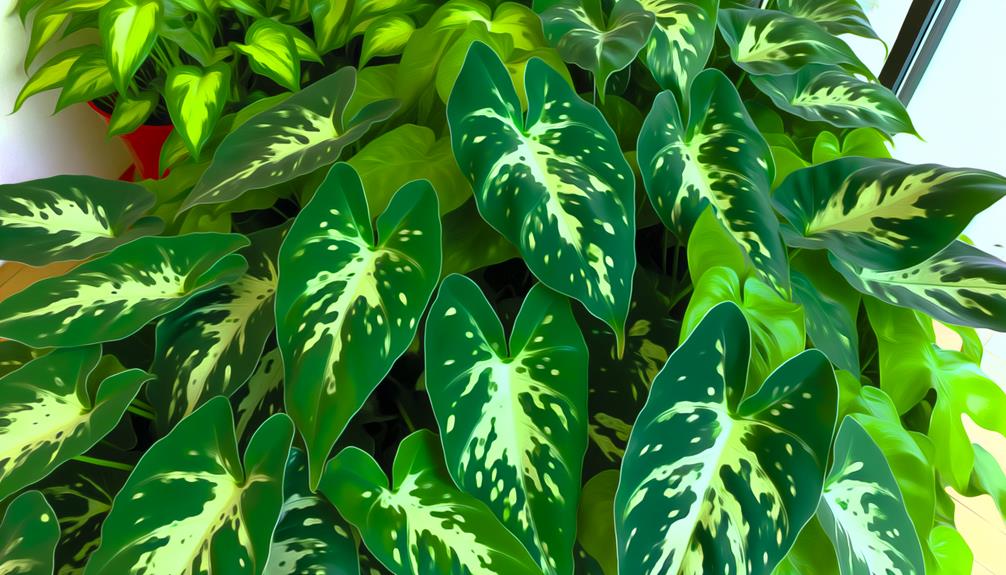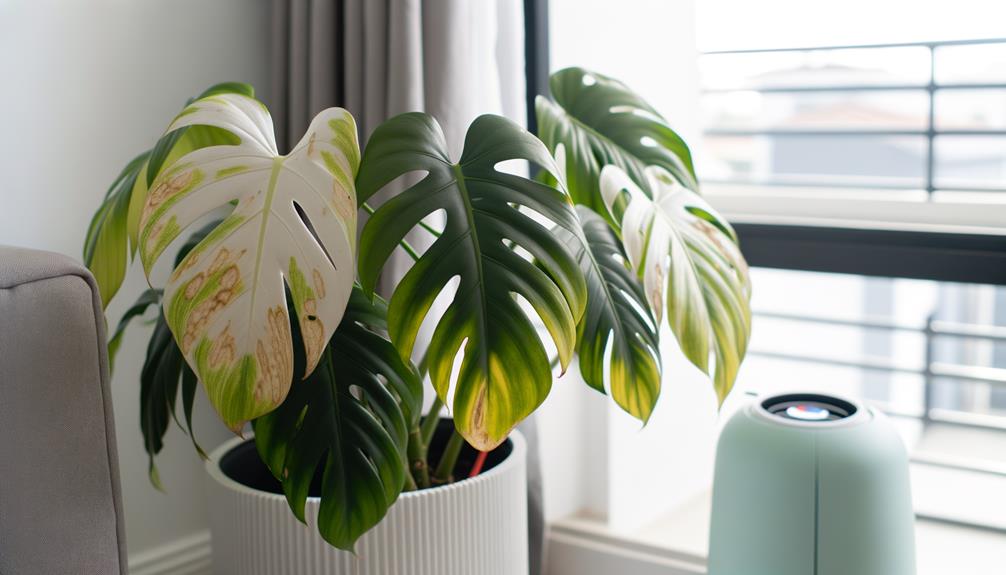How Can I Make My Monstera White? Expert Tips Revealed!
To achieve white variegation in your Monstera, choose a plant with stable genetic mutations, like Monstera albo or Monstera Thai constellation. Make sure it gets bright, indirect light, as direct sunlight can scorch the leaves.
Use well-draining soil and water when the top inch is dry. Maintain humidity around 60-80% and fertilize monthly with a balanced fertilizer containing micronutrients.
Propagate new plants using stem cuttings or air layering from variegated sections. Remember, variegation results from genetic mutations, so consistent white variegation depends on these factors.
For more detailed guidance on maintaining and propagating variegated Monsteras, explore further techniques and tips.

Key Takeaways
- Ensure bright, indirect light to maintain vibrant variegation without scorching the leaves.
- Use a balanced fertilizer with a 20-20-20 NPK ratio to support healthy growth.
- Propagate from variegated stem sections to increase the likelihood of variegated offspring.
- Regularly monitor and maintain humidity levels around 60-80% for optimal growth.
- Remove entirely green leaves to encourage the growth of variegated ones.
Understanding Monstera Variegation

Monstera variegation pertains to the occurrence of white or light-colored patches on the leaves, stemming from a genetic mutation that impacts chlorophyll production.
You’ll observe that these patches lack the green pigment necessary for photosynthesis. This mutation can enhance the plant’s visual appeal but also increase its fragility, as the white sections can’t photosynthesize.
To maintain a healthy variegated Monstera, make sure it receives bright, indirect light. Steer clear of direct sunlight, which can scorch the leaves. Regularly monitor the plant’s water needs, ensuring the soil remains moist but not waterlogged. You should also provide a balanced, diluted fertilizer during the growing season to support overall health.
Proper care will help your Monstera thrive despite its variegation.
Genetic Factors
To achieve a white Monstera, you need to understand the plant’s variegation genetic traits. Variegation can result from specific inheritance patterns, which determine how these traits are passed down.
Additionally, mutations occur at varying frequencies, affecting the likelihood of achieving the desired white coloration.
Variegation Genetic Traits
Understanding variegation genetic traits is essential, as these genetic factors determine whether your Monstera will display the coveted white patterns. Variegation arises from mutations in plant cells’ chlorophyll production, leading to sections with reduced or absent chlorophyll. In Monsteras, this mutation often manifests as white or cream-colored patches.
To encourage variegation, you should focus on obtaining a specimen with stable variegated traits. These traits are typically inherent and not influenced by external factors like light or nutrients. Pay close attention to the plant’s stem and leaf pattern; consistent variegation in new growth indicates a stable genetic trait.
Avoid propagating from non-variegated sections, as they lack the genetic mutation necessary for producing white variegation.
Inheritance Patterns Explained
When it comes to understanding how variegation traits pass from one generation to the next, you’ll need to grasp the basic principles of inheritance patterns and genetic factors.
Variegation in Monsteras is often governed by incomplete dominance, where neither allele is completely dominant. This results in a phenotype that’s a mix of both parental traits.
In variegated Monsteras, the white and green coloration typically follows a Mendelian inheritance pattern. To propagate these traits, make sure you’re selecting cuttings from a variegated parent plant.
Genetic stability varies, so even with careful selection, the variegation can be inconsistent.
Mutation Occurrence Frequency
In studying the genetic factors influencing variegation in Monsteras, you’ll find that mutation occurrence frequency plays an essential role in determining the stability and expression of the white variegation trait. Variegation results from mutations in the chlorophyll-producing genes, which affect pigment distribution.
The table below details critical factors influencing mutation rates and variegation stability:
| Factor | Influence on Mutation Rate | Variegation Stability |
|---|---|---|
| Genetic Background | High variability | Unstable |
| Environmental Stress | Medium variability | Semi-stable |
| Propagation Method | Low variability | Stable |
Understanding these factors helps you manage conditions that might affect your Monstera’s variegation. For instance, propagation methods like tissue culture can enhance stability, while environmental stress can induce mutations but may lead to unstable variegation.
Types of Variegated Monstera

Variegated Monstera varieties, such as Monstera albo and Monstera Thai constellation, exhibit unique patterns of white and green foliage due to genetic mutations affecting chlorophyll production.
Monstera albo, known for its striking white variegation, often has sectoral or marbled patterns. This variety requires bright, indirect light to maintain its variegation.
Monstera Thai constellation, on the other hand, features a more stable variegation with creamy-white speckles and patches, resulting from a deliberate tissue culture process. This stability makes it a preferred choice for enthusiasts.
Both types demand careful attention to light, water, and nutrients to thrive. Adequate humidity and well-draining soil are essential for preventing root rot and ensuring healthy growth of these variegated beauties.
Propagation Techniques
To propagate your Monstera, you can use the stem cutting method, which involves snipping a section of stem with a node and aerial root.
Another option is air layering, where you encourage roots to form on a still-attached stem by wrapping it with moist sphagnum moss.
Node propagation is also effective; simply cut a part of the plant that includes a node and root it in water or soil.
Stem Cutting Method
Stem cutting propagation offers a reliable method to potentially introduce variegation in your Monstera plants. You’ll need a sharp, sterilized knife to make a clean cut below a node, guaranteeing at least one aerial root is included. Place the cutting in water or a well-draining soil mix.
Here’s a quick reference table to guide you:
| Materials Needed | Key Tips |
|---|---|
| Knife, Sterilizer | Ensure sanitation to avoid infection |
| Water/Soil Mix | Choose one based on your preference |
| Bright, Indirect Light | Avoid direct sunlight to prevent leaf burn |
Monitor your cutting for root development and transfer to soil once robust roots form. This method enhances the likelihood of achieving a variegated Monstera.
Air Layering Technique
Air layering is a propagation technique that allows you to encourage root growth on a living Monstera plant before detaching the new plant. First, identify a healthy node on the stem. Make a small incision below this node, about one-third through the stem.
Apply rooting hormone to the wound to stimulate root development. Wrap the incision with moist sphagnum moss, making sure it’s tightly packed. Secure the moss with plastic wrap, creating a humid microenvironment. Check the moss regularly to maintain moisture.
In 4-6 weeks, roots should develop within the moss. Once sufficient roots form, cut below the new root ball and plant it in soil. This method guarantees a higher success rate for propagating variegated Monstera specimens.
Node Propagation Basics
Node propagation is a fundamental technique for growing Monstera plants. It involves cutting a section of the stem that includes at least one node and leaf, then rooting it in soil or water. Start by sterilizing your cutting tool to prevent infection.
Make a diagonal cut just below a node, guaranteeing the node is intact. Place the cutting in water or moist soil, keeping the node submerged but the leaf above the surface. Maintain high humidity and indirect light. Roots should form within a few weeks.
Regularly check for root growth and replace the water to prevent stagnation. Once roots are sufficiently developed, transplant the cutting into a well-draining potting mix. This method ensures healthy propagation and robust growth.
Light Requirements

To achieve the desired white mottling in your Monstera, make sure it receives bright, indirect light. Variegated Monsteras require high light levels to maintain their unique coloration because the white sections lack chlorophyll.
Place your plant near an east or south-facing window, but avoid direct sunlight, which can scorch the leaves. You can also use a grow light to supplement natural light, especially in low-light environments. Monitor the light intensity with a light meter, aiming for 10,000 to 20,000 lumens.
Rotate the plant regularly to ensure even light distribution. Remember, inadequate light will cause the white mottling to diminish over time, leading to reversion to green leaves. Make lighting adjustments accordingly for best mottling.
Nutrient Management
Maintaining ideal nutrient levels is crucial for promoting the white variegation in your Monstera, as deficiencies can result in a loss of this unique coloration.
Start by using a balanced, water-soluble fertilizer with a 20-20-20 NPK ratio. Apply it bi-weekly during the growing season.
Confirm micronutrients like magnesium and iron are present, as these support chlorophyll production without overpowering variegated sections.
Avoid over-fertilizing; high nitrogen levels can stimulate excessive green growth and reduce white variegation.
Test your soil pH regularly, aiming for a slightly acidic range of 5.5 to 6.5. This pH range maximizes nutrient uptake.
Additionally, consider using a slow-release fertilizer to sustain consistent nutrient levels, assisting in the stable development of variegated leaves.
Common Challenges

Cultivating a Monstera with white variegation presents several challenges, including inconsistent variegation patterns and increased susceptibility to pests and diseases. Variegation results from genetic mutations, leading to unpredictable leaf coloration. You might notice leaves reverting to green or displaying uneven white patches.
In addition, white variegated sections lack chlorophyll, making them less efficient at photosynthesis. This can stress the plant, reducing its growth rate and overall vigor. The weakened sections are also more prone to pest infestations and infections.
To manage these challenges, keep an eye on:
- Light Intensity: Provide bright, indirect light to optimize photosynthesis.
- Pest Control: Regularly inspect and treat for common pests like spider mites and aphids.
- Watering Routine: Avoid overwatering as white variegated parts are more susceptible to root rot.
Maintenance Tips
Wondering how to maintain your variegated Monstera in peak condition? Guarantee it receives bright, indirect light, as direct sunlight can scorch its delicate leaves.
Sustain humidity levels around 60-80% to mimic its tropical origins. Use well-draining soil to prevent root rot, and water when the top inch of soil feels dry.
Fertilize monthly with a balanced, water-soluble fertilizer, but avoid over-fertilization, which can harm the plant. Prune judiciously to remove dead or yellowing leaves, promoting healthy growth.
Additionally, rotate the plant periodically to ensure even light exposure, which helps in maintaining balanced variegation. Monitor for pests like spider mites and scale insects, and treat promptly with insecticidal soap or neem oil if necessary.
Realistic Expectations

While providing optimal care for your diverse Monstera is crucial, it’s important to understand that achieving a completely white Monstera isn’t realistically achievable due to the genetic nature of variegation. Variegation occurs because of mutations affecting chlorophyll production, leading to patches of white or cream.
Attempting to increase white areas can compromise the plant’s ability to photosynthesize, impacting its overall health.
To promote healthy variegation, focus on:
- Consistent lighting: Bright, indirect light encourages balanced variegation.
- Proper fertilization: Use a balanced fertilizer to support growth without stressing the plant.
- Pruning: Remove green-only leaves to encourage variegated growth.
Understanding these principles guarantees your Monstera remains vibrant and healthy without unrealistic expectations.
Conclusion
Achieving a white Monstera involves understanding genetic variegation, proper propagation, and ideal care.
For instance, Jane successfully propagated a variegated Monstera by ensuring it had bright, indirect light and balanced nutrients, leading to stunning white leaves.
Remember, even with perfect conditions, variegation isn’t guaranteed. Stay patient and attentive to your plant’s needs.
Embrace the journey, and you’ll likely see rewarding results. Keep experimenting and learning—your dream Monstera is within reach!






